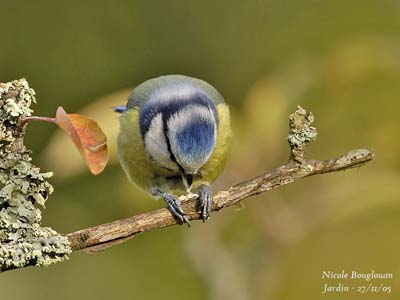
Eurasian Blue Tit
Cyanistes caeruleus
Passeriforme Order - Paridae family
BIOMETRICS :
Length : 11-12 cm ; Weight : 7,5-14 g
LONGEVITY : About 12 years, but often less than 5 years.
DESCRIPTION:
The Blue Tit is a common bird living in parks and gardens. Often seen at bird-feeders, this small bird is very active.

Adult male shows soft yellow-green back and rump. Wings and tail are blue. The upperwing shows white wing-bar, and white-edged flight feathers.

The underparts are pale yellow with narrow blackish line in breast centre. Flanks are brighter yellow, whereas centre of belly is whitish.
The undertail coverts are yellowish-creamy, and the underwings are yellow.
On the head, the crown is blue, surrounded by white stripe, from forehead and lores, above the eyes to the upper nape. A black eye-line becomes blue when joining the dark blue nape where we can see a whitish triangle. Cheeks and ear-coverts are white. Chin is blue-black, extending around the neck as a fine collar.
The small, conical bill is black. Eyes are black. Legs and feet are blue-grey.

Both sexes are similar, but female is slightly duller.
Juvenile is duller and paler. Head shows more dull yellow than white. The upperparts are greyer and slightly greenish. Face and underparts are dull yellow.
This species has several subspecies. They differ in colour intensity, more or less pale or dark.
VOICE: SOUNDS BY XENO-CANTO
Blue Tit utters short and thin “tsee” as contact call, sometimes in series.
The alarm call is a “churrrit” rising at the end.
Calls are very variable, with combination of “tsee”, “tsi” and “tsit” notes, or all mixed in series.
The song is clear and liquid, a trilling “tsi-tsi-sirrrrr-r-r-r”.
HABITAT:
Blue Tit frequents mixed woodlands, thickets, hedgerows, scrubby areas with scattered trees, edges along cultivated fields, orchards, parks and gardens. This bird is often seen in cities.
RANGE:
Blue Tit lives in Europe, Middle East and Western Asia, and North Africa.

BEHAVIOUR:
Blue Tit is very active when feeding. It forages at all levels in vegetation, trees, shrubs and bushes. It can be seen sometimes briefly on the ground.
It searches for invertebrates on leaves, buds and twigs, but it also can move actively through the foliage.
This bird often hangs by one leg, in order to reach some insect. It also may pursue its prey in flight.
Blue Tit is territorial during the breeding season, and it is solitary nester, although sometimes, pairs can nest relatively close to each other.
The place is well defended against intruders.
The male is polygamous and mates with several females. These females nest within the same territory, and the male feeds all the chicks.
Courtship display of the male includes moth-like flights, followed by glides towards the perched female. It also may perform vertical flight and then it dives directly to a low branch. Other display is a kind of dance with horizontal body. At this moment, the tail is fanned and the nape feathers are erected. The wings are spread with dropped tips when the male hops towards the nest-site.

Female receives food from the male during the egg-laying and the incubation. She begs food by shivering wings, as chicks.
They utter short calls during courtship feeding (Xeno-Canto)

Blue Tit is mainly resident in its range, performing some seasonal altitudinal movements. It may be partially migratory in the northern parts of the range.
FLIGHT:
Blue Tit performs fluttering flights. During the breeding season, male performs flight displays in order to attract the females.
REPRODUCTION: Observation Report
Blue Tit breeds from April to late June.
After the courtship displays, the female builds the nest. It is a cup made with moss, dried grasses, leaves, plant fibres, bark strips, hair and feathers. This cup is usually situated in a hole in tree, or other artificial cavities such as nest-boxes.
The female lays 7 to 13 eggs according to the range. Incubation lasts about 12 to 16 days, by female. She is fed by the male at nest. The chicks are fed by both parents with caterpillars and Lepidoptera, and they grow quickly. The nesting period lasts between 16 and 23 days.
This species usually produces two broods per year.


DIET:
Blue Tit feeds mainly on invertebrates and larvae, caterpillars, insects and spiders. It also takes some fruits and seeds, mainly outside of breeding season.
Blue Tit usually feeds alone or in pairs, but we can see small groups in autumn and winter.
This species also frequents the bird-feeders where it consumes bread, cheese, fat and various seeds. It also takes sap from the bark of some trees, and nectar from flowers.
PROTECTION / THREATS / STATUS:
Blue Tit is common or locally abundant. The breeding success depends on the habitat and provision of nest-boxes. It is better in oak woodlands than in conifer forests.
Fr: Mésange bleue
All : Blaumeise
Esp: Herrerillo Común
Ital: Cinciarella
Nd: Pimpelmees
Russe: Синица-лазоревка
Sd: Blåmes
Photos et texte de Nicole Bouglouan
Sources :
HANDBOOK OF THE BIRDS OF THE WORLD Vol 12 by Josep del Hoyo-Andrew Elliott-David Christie - Lynx Edicions - ISBN: 8496553423
THE HANDBOOK OF BIRD IDENTIFICATION FOR EUROPE AND THE WESTERN PALEARCTIC by Mark Beaman, Steve Madge - C.Helm - ISBN: 0713639601
THE COMPLETE BOOK OF BRITISH BIRDS – Written by “Royal Society for the Protection of Birds” experts - Préface de Magnus Magnusson - Michael Cady- Rob Hume Editors - ISBN: 0749509112
The Longevity List (Roland Staav)